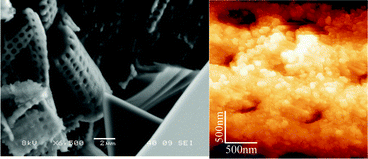Controlling anatase coating of diatom frustules by varying the binding layer†
Abstract
Diatoms have ordered three dimensional porous exoskeletons (frustules) comprised primarily of amorphous

* Corresponding authors
a
Centre for Strategic Nano-fabrication, School of Chemistry and Biochemistry, University Of Western Australia, Crawley, WA-6009, Australia
E-mail:
colin.raston@uwa.edu.au
Fax: +08 6488 8683
Tel: +08 6488 3045
b
Institut National de la Recherche Scientifique, Université du Quebec, 1650 Boul. Lionel Boulet, Varennes, QC, Canada
E-mail:
rosei@emt.inrs.ca
Fax: +1 (450) 929 8102
Tel: +1 (514) 228 8246
Diatoms have ordered three dimensional porous exoskeletons (frustules) comprised primarily of amorphous

 Please wait while we load your content...
Something went wrong. Try again?
Please wait while we load your content...
Something went wrong. Try again?
J. Toster, C. Harnagea, K. Swaminathan Iyer, F. Rosei and C. L. Raston, CrystEngComm, 2012, 14, 3446 DOI: 10.1039/C2CE06648C
To request permission to reproduce material from this article, please go to the Copyright Clearance Center request page.
If you are an author contributing to an RSC publication, you do not need to request permission provided correct acknowledgement is given.
If you are the author of this article, you do not need to request permission to reproduce figures and diagrams provided correct acknowledgement is given. If you want to reproduce the whole article in a third-party publication (excluding your thesis/dissertation for which permission is not required) please go to the Copyright Clearance Center request page.
Read more about how to correctly acknowledge RSC content.
 Fetching data from CrossRef.
Fetching data from CrossRef.
This may take some time to load.
Loading related content
